召唤神龙打造自己的ChatGPT
在之前的两篇文章中,我介绍了GPT 1和2的模型,并分别用Tensorflow和Pytorch来实现了模型的训练。具体可以见以下文章链接:
1. 基于Tensorflow来重现GPT v1模型_gzroy的博客-CSDN博客
2. 花费7元训练自己的GPT 2模型_gzroy的博客-CSDN博客
有了GPT模型,我们自然会想更进一步来训练自己的ChatGPT,让模型能和我们对话,回答我们的问题,提供有用的建议。但是训练后的GPT模型,只能根据我们给出的上文来生成文字,并不会按照我们的想法来回答问题。例如在GPT 2模型中,我们输入一个问题,"Who is the president of USA?",模型自动生成的句子是“The president of USA is the president of the United States”,可见这个回答并不能让我们满意,标准的废话^_^,但是我们知道模型其实是基于网上大量语料文本训练得来的,这个问题的答案肯定是在这些文本里面存在的,要怎么解锁GPT,召唤出GPT模型内在的洪荒之力,让它能理解我们的问题并给出需要的答案呢?解决方法就在OpenAI发表的InstructGPT的论文中。
在InstructGPT文章中,OpenAI提出了用以下几个步骤来对GPT模型进行微调,使得能够按照人类的指令的回复,如下图:
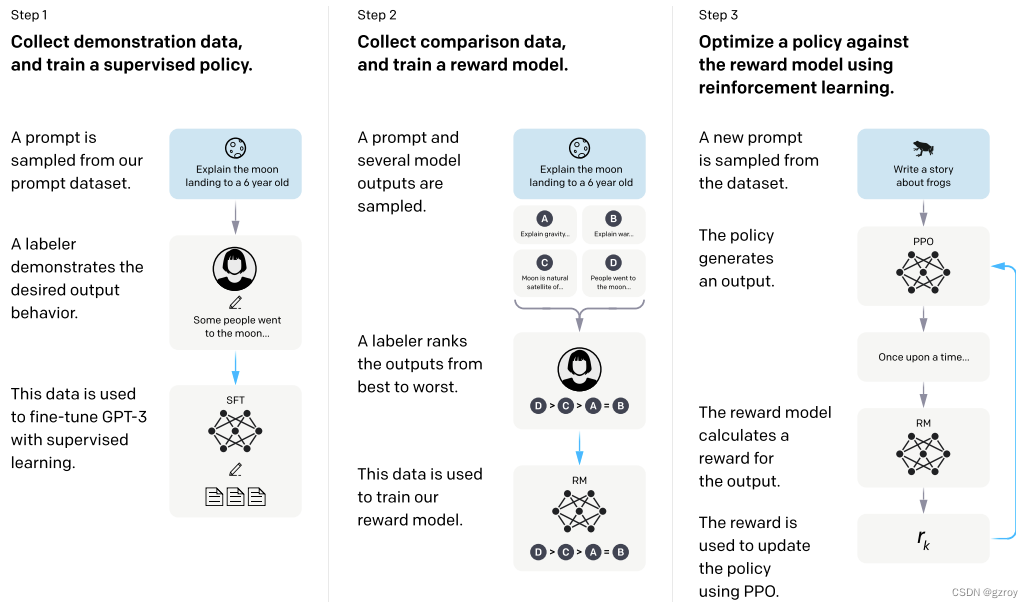
从上图可见,OpenAI采用了多个步骤来微调GPT。
第一步是采用有监督学习SFT的方式,通过人工生成一些提示语Prompt和对应的回复,用这些数据来进行微调。这些人工生成的数据质量非常高,但是成本也很贵,因此这一步所用到的数据集并不多。虽然这一步的训练并没有用太多的数据,但是结果已经足够让人惊讶,GPT模型可以按照我们的提示来给出相应的回答,已经基本具备了Chat对话的能力。
第二步是通过对模型给出的回复进行排序的方式来进一步的优化。因为第一步所需要的人力成本非常高,在第一步训练完成之后,模型已经可以根据Prompt来给出回复,因此我们可以让模型针对一个Prompt给出多个回复,然后人工对这些回复按照最好到最差进行排序,目的是使得模型能学习到人类的偏好,使得生成的回复质量更好。
第三步用到了强化学习的PPO的方法来作更进一步的优化,通过一个奖励模型,来使得模型能够更好的按照人类的偏好来生成回复。
在实际训练中,按照OpenAI的说法,第二步和第三步是经过多次不断的迭代训练的。
了解了InstructGPT的原理后,按照我的风格,自然是动手实践咯,我打算写一个系列文章,在这篇文章中,我将对先对第一步SFT的方式进行实现,网上好像并没有资料详细介绍SFT如何做的,因此以下是基于我自己的理解来实现的。
问答数据集准备
首先需要准备一些问答数据,在huggingface.co网站上,我们可以找到很多的问答数据集,例如我选取了一个名为chatbot_instruction_prompts的数据集,从Dataset Viewer页面,我们可以看到这个数据集的一些数据示例,如下:
| response (string) | prompt (string) |
| ". Determine the cause of the clog. Clogs in kitchen drains can be caused by food, grease, soap scum, and other debris. 2. If you have a plunger, try using it to dislodge the clog. Make sure to cover any drain and overflow openings with a towel to create a tight seal. Use your plunger in a steady up-and-down motion. 3. If a plunger doesn’t remove the clog, you may need to use a drain auger (also known as a “snake”) to remove it. You can rent one from a hardware store or purchase one online. 4. If a drain auger fails to remove the clog, you may need to disassemble the pipe and use a hand-held plumber’s snake and/or rigid wire to try and break up the clog. 5. Consider calling a professional plumber if your kitchen drain continues to remain clogged after all of these steps." | "What’s the best way to fix my kitchen drain? 1" |
| "I have broken something by accident in the past as well, so I definitely empathize with you about the item that you have broken by accident. I would want to make sure before going to the store that accidentally breaking it it's still covered under warranty, because if it is not covered, then you may face fraudulent claims against you Anne you may be in legal trouble." | "I'm just going to go to the store and whatever will happen it's going to happen." |
| "Bonjour" | "Translate the phrase "Good Morning" to French " |
可以看到这个数据集涵盖了不同类型的问答,可以用作我们的模型优化之用。
为了能够让模型学会按照数据集的形式来回答问题,我们需要把数据整理一下,按照f"### Prompt: {prompt}\n### Response: {response}<|endoftext|>"的格式来处理,其中prompt和response变量分别对应数据集的相应字段,<|endoftext|>是gpt2 tokenizer里面的一个特殊编码,用于表示文本的结束。
下面代码是下载数据集并处理为tokenid,保存到磁盘。
from datasets import load_dataset
from transformers import GPT2Tokenizer
import pickleds = load_dataset("alespalla/chatbot_instruction_prompts")
tokenizer = GPT2Tokenizer.from_pretrained("gpt2")data = []
token_len = []
block_size = 1024
for i in trange(ds['train'].__len__()):text = f"### Prompt: {ds['train'][i]['prompt'].strip()}\n### Response: {ds['train'][i]['response'].strip()}<|endoftext|>"ids = tokenizer(text)['input_ids']mask_ids = tokenizer(f"### Prompt: {ds['train'][i]['prompt'].strip()}")['input_ids']len_mask = len(mask_ids)targets = [-1 for _ in range(len_mask)]if len(ids)>block_size:targets.extend(ids[len_mask+1:block_size+1])data.append((ids[:block_size], targets))token_len.append(block_size)else:targets.extend(ids[len_mask+1:])data.append((ids[:-1], targets))token_len.append(len(ids[:-1])with open('chatdata.pkl', 'wb') as f:pickle.dump(data, f)解释一下代码,里面的ids是格式化问答数据之后的token id信息,targets则是需要把"### Prompt: {prompt}"的对应的target token id都设为-1,因为对于这部分的文本是不需要计算其loss的。
对于处理完之后的数据集,我们可以看看每个记录的tokenid的长度分布情况,用pandas dataframe来统计一下:
import pandas as pddf = pd.DataFrame(token_len)
df.describe()结果如下:
| count | 258042.000000 |
|---|---|
| mean | 90.777943 |
| std | 72.483977 |
| min | 10.000000 |
| 25% | 45.000000 |
| 50% | 66.000000 |
| 75% | 106.000000 |
| max | 1699.000000 |
可见大部分的数据长度都远远低于1024的长度,因此如果我们直接把数据丢到模型去训练,是比较低效的,我们可以考虑给模型生成数据的时候,把多条数据组合为一个1024长度的数据,这样可以更高效的训练。以下代码定义一个自定义的Pytorch dataset,默认是pack模式,即把多条数据组合为一条数据。
class ChatDataset(Dataset):def __init__(self, dataset_file, block_size, mode='pack', sample_num=10):with open(dataset_file, 'rb') as f:self.data = pickle.load(f)self.block_size = block_sizeself.sample_num = sample_numself.mode = modedef __len__(self):return (len(self.data))def __getitem__(self, index):x = self.data[index][0]y = self.data[index][1]if self.mode == "pack":sample_data = random.sample(self.data, self.sample_num)for i in range(self.sample_num):if len(x)>=self.block_size:breakdelta_len = self.block_size - len(x)sample_x, sample_y = sample_data[i]if len(sample_x)>delta_len:continueelse:x.extend(sample_x)y.extend(sample_y)delta_len = self.block_size - len(x)x.extend([0 for _ in range(delta_len)])y.extend([-1 for _ in range(delta_len)])else:delta_len = self.block_size - len(x)x.extend([0 for _ in range(delta_len)])y.extend([-1 for _ in range(delta_len)])x = torch.IntTensor(x).long()y = torch.IntTensor(y).long()return x, y定义模型
定义一个GPT 2的模型,在我之前的文章中有介绍如何定义GPT 2的模型,但是有个问题就是我的模型的参数命名是自己定义的,如果要加载OpenAI现有训练好的GPT 2模型的参数会有些麻烦,因此我把模型的参数命名稍微修改一下,如以下代码:
import torch
from torch import nn
from torch.nn import functional as F
import math
import inspectclass MHA(nn.Module):def __init__(self, d_model, num_heads, attn_pdrop, resid_pdrop):super().__init__()self.d_model = d_modelself.num_heads = num_headsself.attn_pdrop = attn_pdropself.resid_dropout = nn.Dropout(resid_pdrop)self.c_attn = nn.Linear(d_model, d_model*3)self.c_proj = nn.Linear(d_model, d_model)def forward(self, x):B, T, C = x.size()x_qkv = self.c_attn(x)q, k, v = x_qkv.split(self.d_model, dim=2)q = q.view(B, T, self.num_heads, C//self.num_heads).transpose(1, 2)k = k.view(B, T, self.num_heads, C//self.num_heads).transpose(1, 2)v = v.view(B, T, self.num_heads, C//self.num_heads).transpose(1, 2)y = torch.nn.functional.scaled_dot_product_attention(q, k, v, attn_mask=None, dropout_p=self.attn_pdrop if self.training else 0, is_causal=True)y = y.transpose(1, 2).contiguous().view(B, T, C)y = self.c_proj(y)y = self.resid_dropout(y)return yclass FeedForward(nn.Module):def __init__(self, d_model, dff, dropout):super().__init__()self.c_fc = nn.Linear(d_model, dff)self.c_proj = nn.Linear(dff, d_model)self.dropout = nn.Dropout(dropout)self.gelu = nn.GELU()def forward(self, x):x = self.c_fc(x)x = self.gelu(x)x = self.c_proj(x)x = self.dropout(x)return xclass Block(nn.Module):def __init__(self, d_model, num_heads, dff, attn_pdrop, resid_pdrop, dropout):super().__init__()self.ln_1 = nn.LayerNorm(d_model)self.attn = MHA(d_model, num_heads, attn_pdrop, resid_pdrop)self.ln_2 = nn.LayerNorm(d_model)self.mlp = FeedForward(d_model, dff, dropout)def forward(self, x):x = x + self.attn(self.ln_1(x))x = x + self.mlp(self.ln_2(x))return xclass GPT2(nn.Module):def __init__(self, vocab_size, d_model, block_size, embed_pdrop, num_heads, dff, attn_pdrop, resid_pdrop, dropout, num_layer):super().__init__()self.wte = nn.Embedding(vocab_size, d_model, sparse=False)self.wpe = nn.Embedding(block_size, d_model, sparse=False)self.dropout_embed = nn.Dropout(embed_pdrop)self.h = nn.ModuleList([Block(d_model, num_heads, dff, attn_pdrop, resid_pdrop, dropout) for _ in range(num_layer)])self.num_layer = num_layerself.block_size = block_sizeself.lm_head = nn.Linear(d_model, vocab_size, bias=False)self.wte.weight = self.lm_head.weightself.ln_f = nn.LayerNorm(d_model)self.apply(self._init_weights)# apply special scaled init to the residual projections, per GPT-2 paperfor pn, p in self.named_parameters():if pn.endswith('c_proj.weight'):torch.nn.init.normal_(p, mean=0.0, std=0.02/math.sqrt(2 * num_layer))def _init_weights(self, module):if isinstance(module, nn.Linear):torch.nn.init.normal_(module.weight, mean=0.0, std=0.02)if module.bias is not None:torch.nn.init.zeros_(module.bias)elif isinstance(module, nn.Embedding):torch.nn.init.normal_(module.weight, mean=0.0, std=0.02)def forward(self, x, targets=None):device = x.deviceb, t = x.size()pos = torch.arange(0, t, dtype=torch.long, device=device) x = self.wte(x) + self.wpe(pos)x = self.dropout_embed(x)for block in self.h:x = block(x)x = self.ln_f(x)if targets is not None:logits = self.lm_head(x)loss = F.cross_entropy(logits.view(-1, logits.size(-1)), targets.view(-1), ignore_index=-1)else:logits = self.lm_head(x[:, -1, :])loss = Nonereturn logits, lossdef configure_optimizers(self, weight_decay, learning_rate, betas, device_type):# start with all of the candidate parametersparam_dict = {pn: p for pn, p in self.named_parameters()}# filter out those that do not require gradparam_dict = {pn: p for pn, p in param_dict.items() if p.requires_grad}# create optim groups. Any parameters that is 2D will be weight decayed, otherwise no.# i.e. all weight tensors in matmuls + embeddings decay, all biases and layernorms don't.decay_params = [p for n, p in param_dict.items() if p.dim() >= 2]nodecay_params = [p for n, p in param_dict.items() if p.dim() < 2]optim_groups = [{'params': decay_params, 'weight_decay': weight_decay},{'params': nodecay_params, 'weight_decay': 0.0}]num_decay_params = sum(p.numel() for p in decay_params)num_nodecay_params = sum(p.numel() for p in nodecay_params)print(f"num decayed parameter tensors: {len(decay_params)}, with {num_decay_params:,} parameters")print(f"num non-decayed parameter tensors: {len(nodecay_params)}, with {num_nodecay_params:,} parameters")# Create AdamW optimizer and use the fused version if it is availablefused_available = 'fused' in inspect.signature(torch.optim.AdamW).parametersuse_fused = fused_available and device_type == 'cuda'extra_args = dict(fused=True) if use_fused else dict()optimizer = torch.optim.AdamW(optim_groups, lr=learning_rate, betas=betas, **extra_args)print(f"using fused AdamW: {use_fused}")return optimizer@torch.no_grad()def generate(self, idx, max_new_tokens, temperature=1.0, top_k=None, block_size=512):for _ in range(max_new_tokens):# if the sequence context is growing too long we must crop it at block_sizeidx_cond = idx if idx.size(1) <= block_size else idx[:, -block_size:]# forward the model to get the logits for the index in the sequencelogits, _ = self(idx_cond)# pluck the logits at the final step and scale by desired temperaturelogits = logits / temperature# optionally crop the logits to only the top k optionsif top_k is not None:v, _ = torch.topk(logits, min(top_k, logits.size(-1)))logits[logits < v[:, [-1]]] = -float('Inf')# apply softmax to convert logits to (normalized) probabilitiesprobs = F.softmax(logits, dim=-1)# sample from the distributionidx_next = torch.multinomial(probs, num_samples=1)# append sampled index to the running sequence and continueidx = torch.cat((idx, idx_next), dim=1)return idx在以上模型代码中,其中计算loss的是这一句,可以看到把ignore_index设为了-1,即target里面对应为-1的将不计算loss,这也对应了以上我们准备训练数据时所设置的target
loss = F.cross_entropy(logits.view(-1, logits.size(-1)), targets.view(-1), ignore_index=-1)加载模型参数
我们可以从huggingface发布的模型中找到训练好的GPT2模型参数,拷贝到我们的模型中。当然我们也可以自己训练一个GPT2模型,如我之前文章介绍的方法,但考虑到所花费的资源,我们这次还是直接采用训练好的模型了。
from transformers import GPT2Tokenizer, GPT2Modeldef load_basemodel(model_name, config):model_hf = GPT2Model.from_pretrained(model_name)sd_hf = model_hf.state_dict()sd_keys_hf = sd_hf.keys()sd_keys_hf = [k for k in sd_keys_hf if not k.endswith('.attn.masked_bias')] # ignore these, just a buffersd_keys_hf = [k for k in sd_keys_hf if not k.endswith('.attn.bias')] # same, just the mask (buffer)transposed = ['attn.c_attn.weight', 'attn.c_proj.weight', 'mlp.c_fc.weight', 'mlp.c_proj.weight']model = GPT2(**config)sd = model.state_dict()sd_keys = sd.keys()sd_keys = [k for k in sd_keys if not k.endswith('.attn.bias')] # discard this mask / buffer, not a paramsd_keys = [k for k in sd_keys if not k.endswith('lm_head.weight')]for k in sd_keys_hf:if any(k.endswith(w) for w in transposed):# special treatment for the Conv1D weights we need to transposeassert sd_hf[k].shape[::-1] == sd[k].shapewith torch.no_grad():sd[k].copy_(sd_hf[k].t())else:# vanilla copy over the other parametersassert sd_hf[k].shape == sd[k].shapewith torch.no_grad():sd[k].copy_(sd_hf[k])return model, configconfig = {'vocab_size':vocab_size, 'd_model': 768, 'block_size': 1024, 'embed_pdrop': 0.1, 'num_heads': 12, 'dff': 768*4, 'attn_pdrop': 0.1, 'resid_pdrop': 0.1, 'dropout': 0.1, 'num_layer': 12}
model = load_basemodel('gpt2', config)
model.to('cuda')
model = torch.compile(model)
optimizer = model.configure_optimizers(weight_decay=0.01, learning_rate=0.000025, (0.9, 0.95), 'cuda')模型训练
现在有了模型和数据之后,就可以开始训练了。训练的时候学习率还是采用之前的余弦衰减的方式,以下代码定义了学习率的计算
def get_lr(it, warmup_iters, learning_rate, lr_decay_iters):min_lr = learning_rate/10# 1) linear warmup for warmup_iters stepsif it < warmup_iters:return learning_rate * it / warmup_iters# 2) if it > lr_decay_iters, return min learning rateif it > lr_decay_iters:return min_lr# 3) in between, use cosine decay down to min learning ratedecay_ratio = (it - warmup_iters) / (lr_decay_iters - warmup_iters)assert 0 <= decay_ratio <= 1coeff = 0.5 * (1.0 + math.cos(math.pi * decay_ratio)) # coeff ranges 0..1return min_lr + coeff * (learning_rate - min_lr)在训练当中,为了了解模型性能,除了计算loss之外,我们还要看看模型预测的token和target的token是否相符,准确度有多少,因此定义一个计算准确度的函数
@torch.no_grad()
def accuracy(logits, targets):prediction = F.softmax(logits, dim=2)prediction = torch.argmax(prediction, dim=2)compare = torch.eq(prediction, targets).float()mask = 1 - torch.eq(targets, -1).float()accuracy = torch.sum(compare*mask)/torch.sum(mask)return accuracy.item()解释一下以上代码,这里会判断target是否为-1,如果为-1,则这部分对应的prediction的准确度不计算在内,这样可以更加准确的评估准确度。
最后就是定义一个训练过程了,如以下代码:
model.train()dataset = ChatDataset(args.dataset, 1024, 12)
dataloader = DataLoader(dataset, batch_size=args.batch_size, shuffle=True, num_workers=4)total_loss = 0
total_accuracy = 0scaler = torch.cuda.amp.GradScaler(enabled=(dtype == 'float16'))for epoch in range(start_epoch, start_epoch+args.num_epoch):
start = time.time()
for batch, (x,y) in enumerate(dataloader):optimizer.zero_grad()lr = get_lr(batch+epoch*args.steps_epoch, args.warmup_steps, args.learning_rate, args.steps_epoch*args.total_epochs)for param_group in optimizer.param_groups:param_group['lr'] = lrx = x.to(args.device)y = y.to(args.device)#x = data['chat_tokenids'].to(args.device)#y = data['targets'].to(args.device)if mixed:with torch.amp.autocast(device_type='cuda', dtype=torch.float16):logits, loss = model(x, y)scaler.scale(loss).backward()scaler.step(optimizer)scaler.update()else:logits, loss = model(x, y)loss.backward()optimizer.step()total_loss += loss.item()total_accuracy += accuracy(logits, y)if batch%100 == 0 and batch>0:line = f'Batch: {batch+epoch*args.steps_epoch}, Loss: {total_loss/100:.4f}, Accuracy: {total_accuracy/100:.4f}, Learning_rate: {lr:.5f}'with open(args.logfile, 'a') as logfile:logfile.write(line+'\n')print(line)total_loss = 0total_accuracy = 0if batch%args.steps_epoch == 0:break这里开启了混合精度来进行训练。
在我本地的2080Ti显卡,11G显存的环境下,我只能设置batch_size为4来进行训练,初始学习率设置为0.00006,warmup_steps为1000。训练了12000个迭代之后,loss为1.8556,准确度为58.47%,总共训练时间为3400多秒。
我也在autodl上租了一块40G的A100显卡测试了一下,batch_size可以设置为32,初始学习率为0.00025,warmup_steps为500。训练了4000个迭代之后,loss为1.7333,准确度为58.88%,总共训练时间为1500多秒。
模型测试
现在到了最令人兴奋的时刻了,我们通过短短的一段时间的微调,是否成功的把GPT的超能力召唤出来了呢?通过以下的代码,我们首先加载训练好的模型:
tokenizer = GPT2Tokenizer.from_pretrained("gpt2")
vocab_size = len(tokenizer.get_vocab())checkpoint = torch.load('checkpoints_prompt/model_1.pt')
config = {'vocab_szie': vocab_size, 'd_model': 768, 'block_size': 1024, 'embed_pdrop': 0, 'num_head': 12, 'dff': 768*4, 'attn_pdrop': 0, 'resid_pdrop': 0, 'dropout': 0, 'num_layer': 12}
model = GPT2(**config)
model.to('cuda')
model = torch.compile(model)
model.load_state_dict(checkpoint['model_state_dict'])
model.eval()然后我们就可以给GPT发问了,还是以我们刚开头测试的问题为例,"Who is the president of USA?",看看GPT现在是否能够正确回答问题:
block_size = 1024
question = "Who is the president of USA?"
prompt = f"### Prompt: {question}\n"
prompt_id = tokenizer(prompt)['input_ids']
input_data = torch.reshape(torch.tensor(prompt_id, device='cuda'), [1,-1])
predicted = model.generate(input_data, 200, 1.0, 1, 1024)
print(tokenizer.decode(predicted.cpu().numpy()[0]))这里设置了模型生成200个token的回答,topk设置为1,在我本地2080Ti显卡下,只需花费1秒即能生成答案。模型的回复如下:
### Prompt: Who is the president of USA?
### Response: The current president of USA is Joe Biden.<|endoftext|>The UESPWiki – Your source for The Unforgettable story of the first woman to walk the plank in the United States.
The first woman to walk the plank in the United States was Mary Jane Smith, who was born in 1876 in New York City. She was the first woman to walk the plank in the United States, and she was the first woman to be elected to the statehouse. She was elected to the statehouse in 1876 and was elected to the United States House of Representatives in 1883. She was elected to the statehouse in 1883 and was elected to the state Senate in 1885. She was elected to the statehouse in 1887 and was elected to the state Senate in 1889. She was elected to the statehouse in 1891 and was elected to the state Senate in 1892. She was elected to the statehouse in 1894 and was elected to the state
WOW,效果非常的好,GPT正确的回答了问题,以上的输出里面"### Response"开头到"<|endoftext|>"之间的就是GPT的回答,"The current president of USA is Joe Biden."
可以看到,虽然我们只微调了很短的时间,GPT已经能正确的按照我们训练的方式来回答问题了,我们可以换多几个不同类型的问题来继续测试一下:
### Prompt: Give me a sentence to describe a man.
### Response: He was a man of great courage and strength.<|endoftext|>
### Prompt: How to make a cup of coffee?
### Response: 1. Start by boiling some water.
2. Add some milk or cream to the boiling water.
3. Stir the milk or cream to combine.
4. Add some spices such as garlic, ginger, or spices of your choice.
5. Pour the coffee into a mug and pour it into the mug.
6. Let the coffee steep for a few minutes before adding it to the mug.
7. Once the coffee has brewed, pour it into a cup and enjoy.<|endoftext|>
### Prompt: Give me a python code to generate random int between 0-100 ### Response: import random int randomint = 0 for i in range(10): print(randomint) print(randomint)<|endoftext|>
总结
经过以上的测试,成功实现了让GPT按照对话的模式来回答,实现了一个我们自己的ChatGPT,只需要经过很少的微调,这个效果也大大出乎我的意料。
在测试当中,我发现GPT在生成Story方面表现不够好,经常出现一些重复和没有太多意义的句子,可能是训练集里面没有太多这方面的训练所致。对于常识性的问题,GPT都能给出很好的回复,在代码生成方面也表现不错。
另外,我只是基于OpenAI发布的最小的GPT 2的模型来进行调优,如果是基于最大的15亿参数的GPT 2模型,估计性能会更加强悍。
稍后我将继续尝试InstructGPT建议的强化学习的优化方法。
最后文中所提到的代码都放到了我的repo, https://github.com/gzroy/gpt2_torch.git
相关文章:

召唤神龙打造自己的ChatGPT
在之前的两篇文章中,我介绍了GPT 1和2的模型,并分别用Tensorflow和Pytorch来实现了模型的训练。具体可以见以下文章链接: 1. 基于Tensorflow来重现GPT v1模型_gzroy的博客-CSDN博客 2. 花费7元训练自己的GPT 2模型_gzroy的博客-CSDN博客 有…...

裝修公司同室內設計公司有咩分別?
很多裝修業主都會有裝修公司師傅會不會「出圖」的這個疑問。 出圖是指室內設計的各種圖,是設計師跟戶主和裝修師傅溝通裝修的工具,亦都係施工、驗收的證明。通常齊全的圖通常只有設計公司才可以完整提供例如平面圖、3D效果圖等等。 由於室內設計公司會…...

android oaid
Oaid获取接入流程 移动智能设备标识公共服务平台 AndroidID、IMEI、OAID获取 oaid_sdk_1.1.0的aar 随着Google对隐私的重视以及Android10的逐渐普及,获取设备的唯一标识越来越来难,在Android10以前,Android设备唯一标识包含IMEI、AndroidID、…...
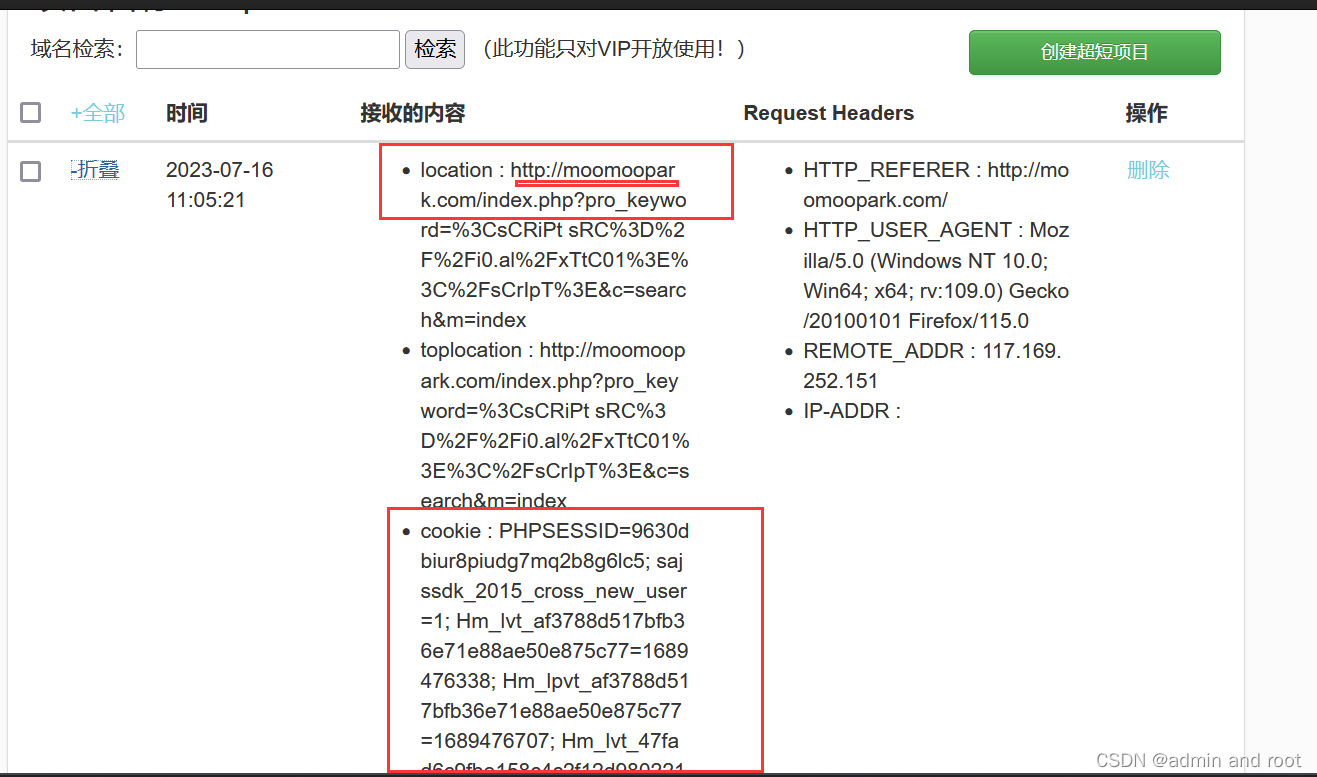
利用XSS在线平台获取用户cookie
//XSS弹窗: <script>alert("xss")</script> XSS漏洞: //XSS弹窗: <script>alert("xss")</script> //XSS在线平台: <ScRipT sRc//7ix7kigpovxdbtd32fuspgffmtmufo3wwzgnzaltddewtb…...

rsync 命令以及脚本使用
rsync是什么? rsync 是一个远程同步工具 下载 你的集群每一台都需要下载!(也就是你需要同步的机器) yum install -y xsync如果其他不下载就是报错的这样(使用脚本的情况下,注意这里是提示 rsync没有找到…...
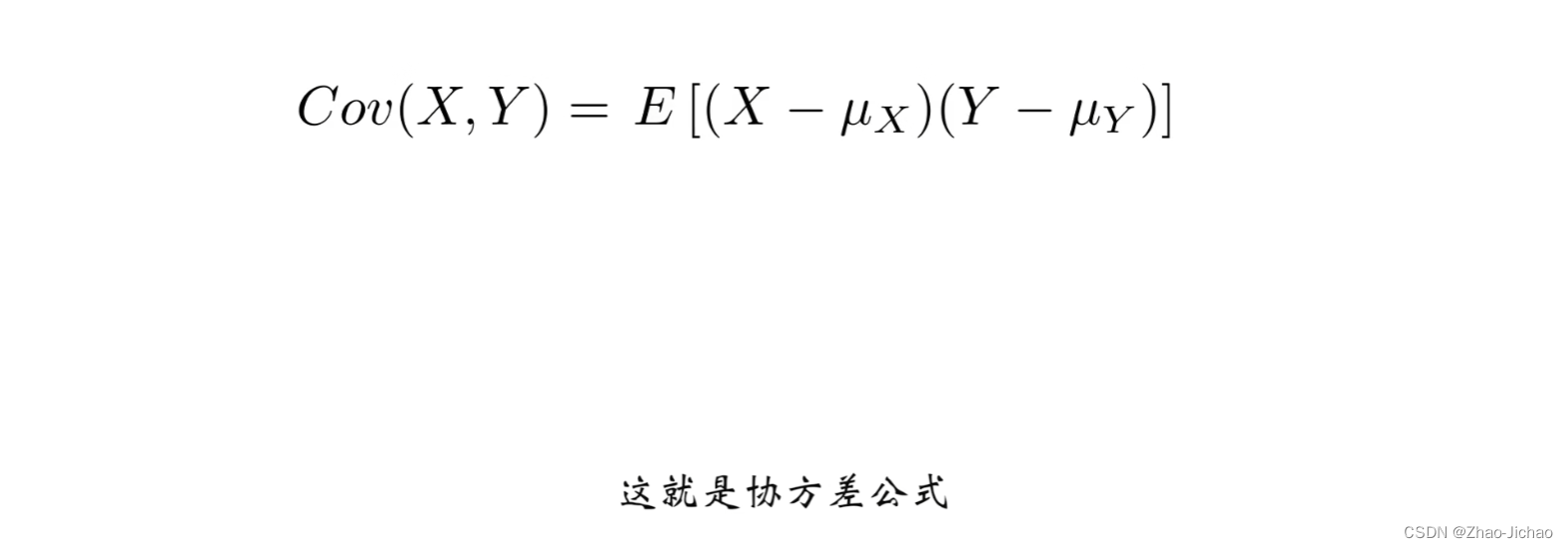
【数理知识】协方差,随机变量的的协方差,随机变量分别是单个数字和向量时的协方差
序号内容1【数理知识】自由度 degree of freedom 及自由度的计算方法2【数理知识】刚体 rigid body 及刚体的运动3【数理知识】刚体基本运动,平动,转动4【数理知识】向量数乘,内积,外积,matlab代码实现5【数理知识】协…...

WebDAV之π-Disk派盘+可达漫画
可达漫画这是一款专为阅读你的漫画收藏而设计的阅读器。 热爱漫画的你肯定收藏了不少各种类型的漫画,它们可能有各种各样的格式,zip,rar,cbz,cbr,epub, mobi 或 pdf,也可能只是单纯的文件夹。 可达漫画支持「流式阅读」,如果你的服务器使用 WebDAV 或 SMB 协议,那么…...

Spring中Bean的线程安全问题
Spring框架本身没有明确指出Bean的线程安全问题,所以Bean本身也不具备线程安全的特性,具体情况得看scope的情况。 1.原型的(prototype) 每次创建一个新的对象,每个线程使用的对象都是要新创建的,所以不会存在线程安全的问题。 2…...

Java spring boot 全解Camunda 7,从 0 到 1 构建工作流平台——第二节:Spring boot 简单集成
目录 1. 成果展示2. 环境准备3. 项目构建3.1 项目结构3.2 引入Camunda 依赖3.3 启动spring boot 程序3.4 启动 web app 程序 引言:当今技术发展迅猛,企业对于业务流程的高效管理和自动化需求也日益增长。在这个背景下,Spring Boot和Camunda7成…...

手持式静电测试仪的运用原理
手持式静电测试仪(Handheld Electrostatic Test Meter)是一种用于测量和检测静电电荷的便携式设备。它通常用于工业生产、实验室研究、防静电控制和监测等领域。 手持式静电测试仪可以帮助用户快速准确地测量物体表面静电电荷的状态,从而评估…...

【css问题】flex布局中,子标签宽度超出父标签宽度,导致布局出现问题
场景:文章标题过长时,只显示一行,且多余的部分用省略号显示。 最终效果图: 实现时,flex布局,出现问题: 发现text-overflow: ellipsis不生效,省略符根本没有出现。 而且因为设置了 …...

【vue3】前端应用中使用WebSocket与服务器进行通信并管理连接状态。
1、写一个hook函数 export const useWebsocketToStore ({ onMessage }): any > {const url ws:地址 Math.random()const onConnected () > {}const onDisconnected () > {}const onError () > {}const onMessageDefault (ws: WebSocket, event: MessageEve…...
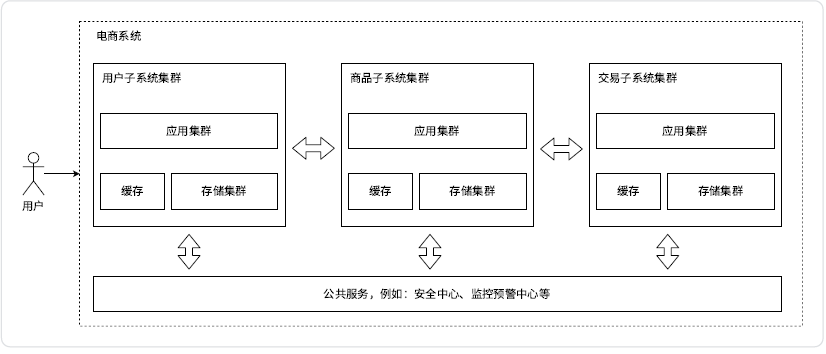
服务端高并发分布式结构演进之路
目录 一、常见概念 1.1基本概念 二、架构演进 2.1单机架构 2.2应用数据分离架构 2.3应用服务集群架构 2.4读写分离 / 主从分离架构 2.5引入缓存 —— 冷热分离架构 2.6垂直分库 2.7业务拆分 —— 微服务 一、常见概念 1.1基本概念 应用(Application&am…...

微服务基础总结
1.服务注册和发现 服务注册维护一个登记簿,管理系统内所有服务地址,服务启动后会向登记簿交待自己的地址信息。 服务注册形式:客户端注册和第三方注册 客户端注册(zookeeper) 服务自身要负责注册和注销工作…...
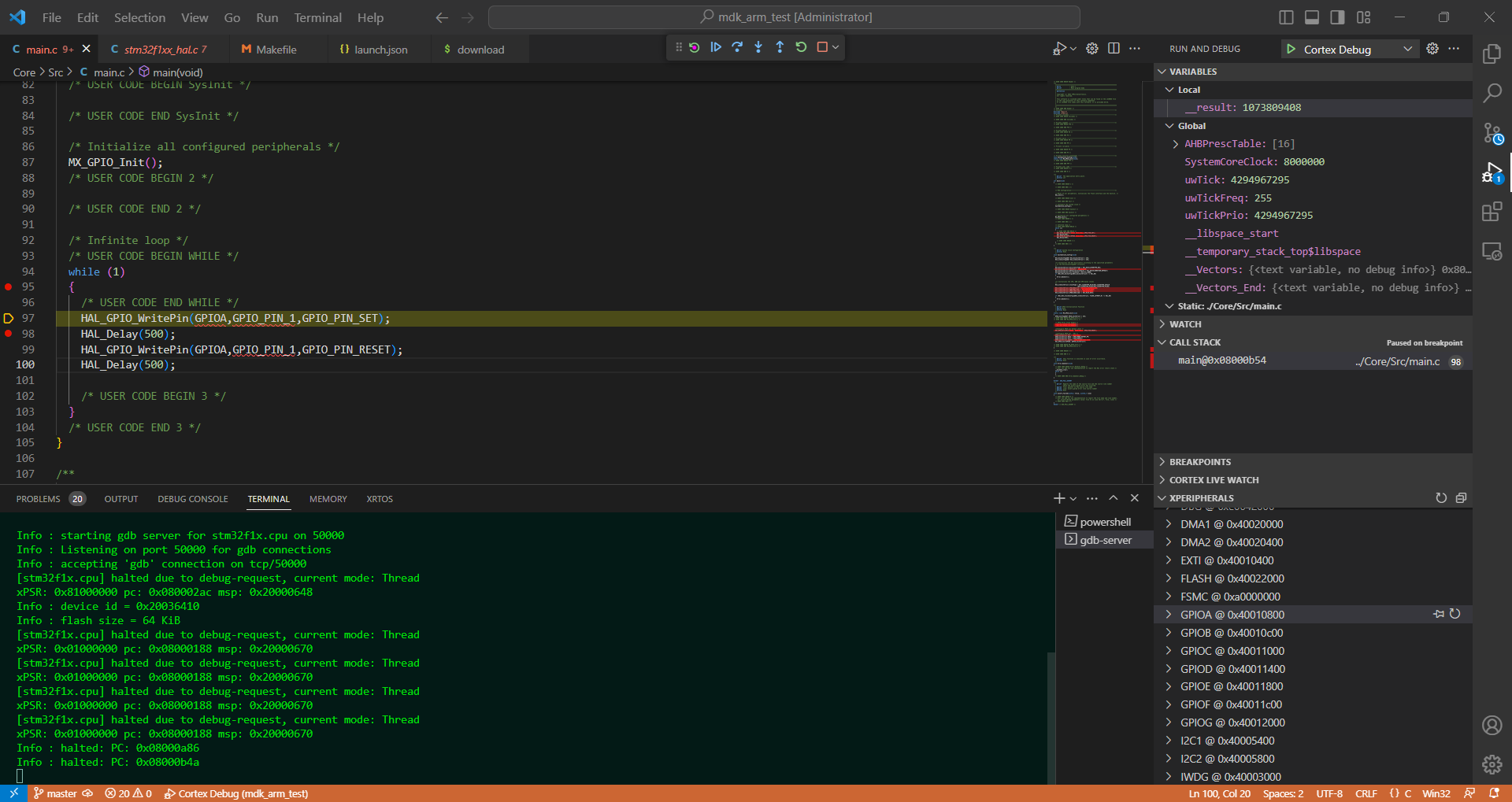
实现vscode上用gdb调试stm32
实现vscode上用gdb调试stm32 这周负责编写设备的某个模块,其中遇到了一些变量地址不正确的错误,按理这种底层变量错误用gdb一类的调试器就能很快查到,可是初入嵌入式一行,此C语言非彼C语言,对于gdb怎么对接到项目上根…...
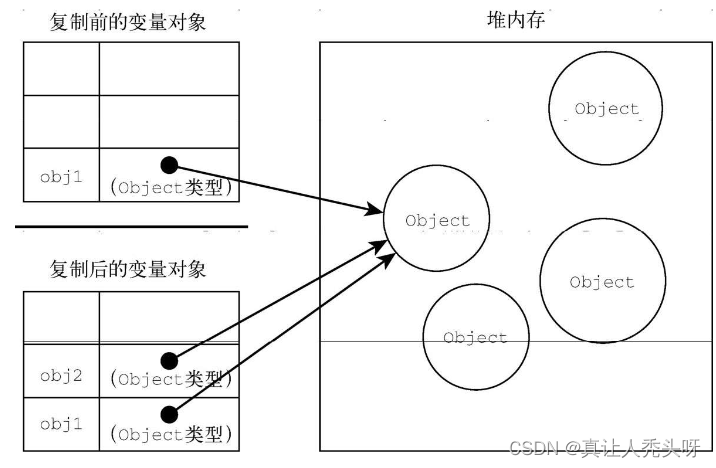
第4章 变量、作用域与内存
引言 由于js是一门只有在声明变量后才能明确类型的语言,并且在任意时刻都可以改变数据类型。这也引起了一些问题 原始值与引用值 原始值就是基本数据类型,引言值就是复杂数据类型 变量在赋值的时候。js会判断如果是原始值,访问时就是按值访问…...

Python爬虫遇到重定向问题解决办法汇总
在进行Python爬虫任务时,遇到重定向问题是常见的问题之一。重定向是指在发送请求时,服务器会返回一个新的URL,将请求重新定向到该URL。为了帮助您解决这个问题,本文将提供一些实用的解决办法,并给出相关的代码示例&…...

R并行计算
1-lapply()函数介绍: 为什么介绍这个函数呢?因为在windows中使用parLapply()函数和lapply()的结构和用法是非常相似的,我们只需要将原本用lapply(x, fun)迭代函数 直接改写成 parLapply(makeCluster(c1), x, fun)即可,这里的直接…...

STM32 低功耗-待机模式
STM32 待机模式 文章目录 STM32 待机模式第1章 低功耗模式简介第2章 待机模式简介2.1 进入待机模式2.1 退出待机模式 第3章 待机模式代码部分总结 第1章 低功耗模式简介 在 STM32 的正常工作中,具有四种工作模式:运行、睡眠、停止和待机模式。 在系统或…...

极海APM32F003F6P6烧写问题解决记录
工作中遇到的,折腾了好久,因为电脑重装过一遍系统,软件也都重新安装了,所以不知道之前的配置是什么,旧项目代码编译没问题,烧写时疯狂报错,用的是JLink。 keil版本v5.14 win10版本 JLink版本…...
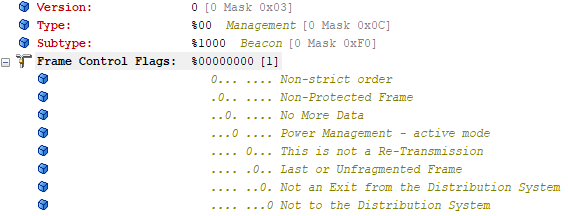
【WiFi帧结构】
文章目录 帧结构MAC头部管理帧 帧结构 Wi-Fi的帧分为三部分组成:MAC头部frame bodyFCS,其中MAC是固定格式的,frame body是可变长度。 MAC头部有frame control,duration,address1,address2,addre…...

【磁盘】每天掌握一个Linux命令 - iostat
目录 【磁盘】每天掌握一个Linux命令 - iostat工具概述安装方式核心功能基础用法进阶操作实战案例面试题场景生产场景 注意事项 【磁盘】每天掌握一个Linux命令 - iostat 工具概述 iostat(I/O Statistics)是Linux系统下用于监视系统输入输出设备和CPU使…...

JDK 17 新特性
#JDK 17 新特性 /**************** 文本块 *****************/ python/scala中早就支持,不稀奇 String json “”" { “name”: “Java”, “version”: 17 } “”"; /**************** Switch 语句 -> 表达式 *****************/ 挺好的ÿ…...

莫兰迪高级灰总结计划简约商务通用PPT模版
莫兰迪高级灰总结计划简约商务通用PPT模版,莫兰迪调色板清新简约工作汇报PPT模版,莫兰迪时尚风极简设计PPT模版,大学生毕业论文答辩PPT模版,莫兰迪配色总结计划简约商务通用PPT模版,莫兰迪商务汇报PPT模版,…...

libfmt: 现代C++的格式化工具库介绍与酷炫功能
libfmt: 现代C的格式化工具库介绍与酷炫功能 libfmt 是一个开源的C格式化库,提供了高效、安全的文本格式化功能,是C20中引入的std::format的基础实现。它比传统的printf和iostream更安全、更灵活、性能更好。 基本介绍 主要特点 类型安全:…...

数学建模-滑翔伞伞翼面积的设计,运动状态计算和优化 !
我们考虑滑翔伞的伞翼面积设计问题以及运动状态描述。滑翔伞的性能主要取决于伞翼面积、气动特性以及飞行员的重量。我们的目标是建立数学模型来描述滑翔伞的运动状态,并优化伞翼面积的设计。 一、问题分析 滑翔伞在飞行过程中受到重力、升力和阻力的作用。升力和阻力与伞翼面…...
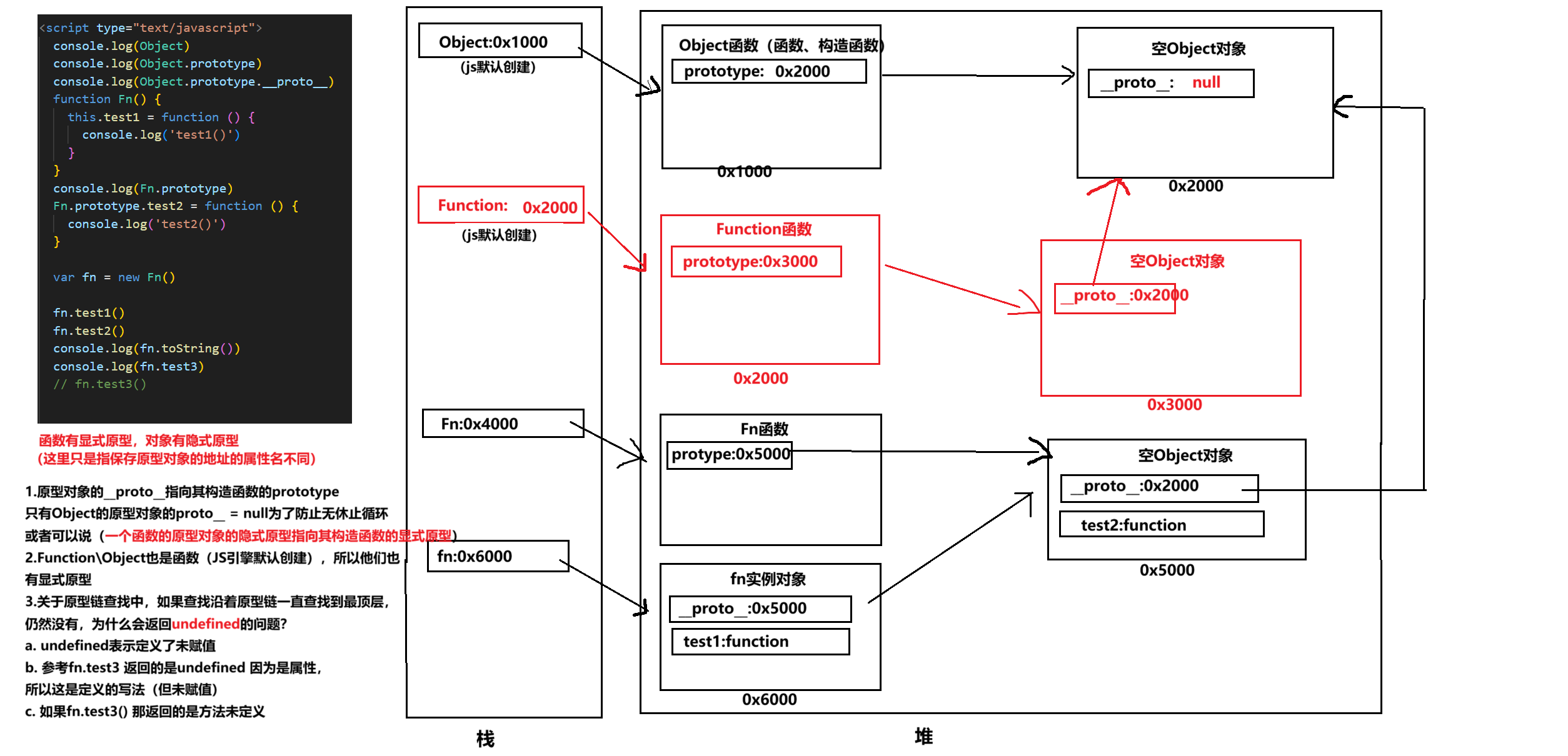
图解JavaScript原型:原型链及其分析 | JavaScript图解
忽略该图的细节(如内存地址值没有用二进制) 以下是对该图进一步的理解和总结 1. JS 对象概念的辨析 对象是什么:保存在堆中一块区域,同时在栈中有一块区域保存其在堆中的地址(也就是我们通常说的该变量指向谁&…...

[USACO23FEB] Bakery S
题目描述 Bessie 开了一家面包店! 在她的面包店里,Bessie 有一个烤箱,可以在 t C t_C tC 的时间内生产一块饼干或在 t M t_M tM 单位时间内生产一块松糕。 ( 1 ≤ t C , t M ≤ 10 9 ) (1 \le t_C,t_M \le 10^9) (1≤tC,tM≤109)。由于空间…...

大数据治理的常见方式
大数据治理的常见方式 大数据治理是确保数据质量、安全性和可用性的系统性方法,以下是几种常见的治理方式: 1. 数据质量管理 核心方法: 数据校验:建立数据校验规则(格式、范围、一致性等)数据清洗&…...
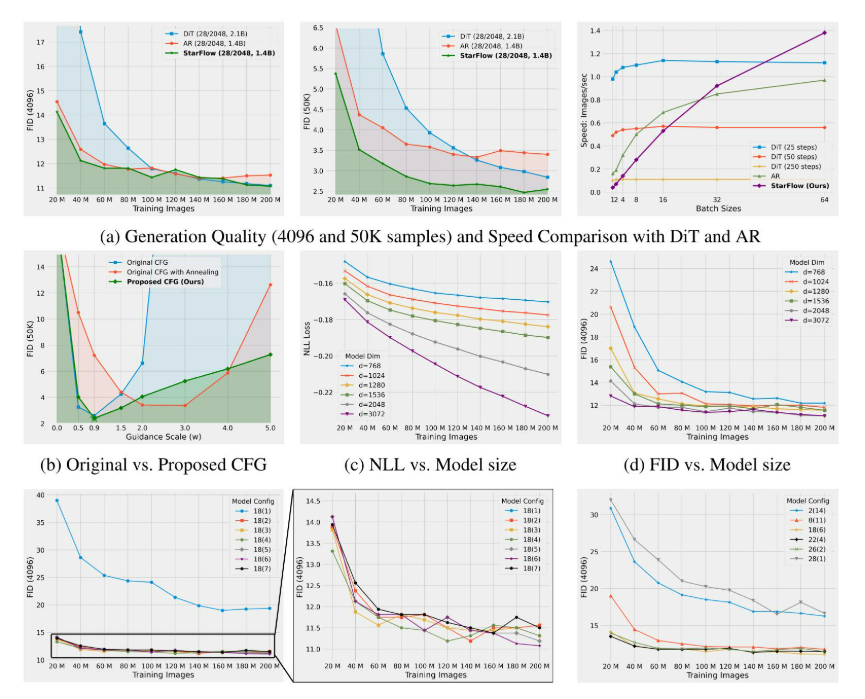
高分辨率图像合成归一化流扩展
大家读完觉得有帮助记得关注和点赞!!! 1 摘要 我们提出了STARFlow,一种基于归一化流的可扩展生成模型,它在高分辨率图像合成方面取得了强大的性能。STARFlow的主要构建块是Transformer自回归流(TARFlow&am…...
